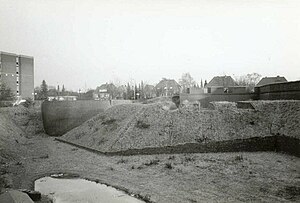Tenaill system
Tenaill system is a technical term from fortress construction and describes a fastening system with a star-shaped floor plan without the use of bastions and curtains . This fastening system is mainly based on the manners of Hermann Landsberg the Younger (1670–1746) and Marc-René de Montalembert .
The Tenaill System or Tenaillentracé
The term Tenaillensystem is derived from the French: tenaille (pliers) and describes a fortification, the walls of which consist only of protruding (saillants) and re-entrant angles (rentrants). The Tenaill system is (as its French name suggests) a purely flanking system. Each wall line is flanked by an opposite line of the same type. Since there are no curtains in this system, it is relatively difficult to paint (bombard) the area in front of the fortress, and it also has the disadvantage that enfiltration batteries can bombard the main wall even if they are still relatively far away from the fortress. However - with the flanks of the bastions being enlarged at the same time - the curtain wall in all the newer bastionary systems was also only very short. To strengthen the frontal fire, bonnets were used in both systems (here: an elevation and reinforcement of the parapet in the protruding corner, in order to be able to better coat the apron on the one hand and to provide better protection against enfiltration on the other hand). The frontal fire was intensified by the installation of powerful reduits and / or - since Montalembert - multi-storey artillery towers in the throat of the protruding corners.
The Tenaill system is a flexible system and can therefore be easily integrated into the terrain, but it takes up a large area. It is also called “perpendiculaire” because it has been shown that the re-entrant angles must be at least 90 °, which means that it can only be used from a certain size. An essential element of a functioning Tenaillen fortification is also the envelope , which has been developed from the crescent moons and ravelines in the main ditch since the "old Dutch manner".
The tenaille or trench scissors
Despite the name, the tenaille (in German: trench shears ) has nothing to do with the tenaille system (see also main article Tenaille ). The French name is derived in both cases from the fact that these are flanking works. The tenaille is ultimately a short envelope (cover wall ) or a Faussebraye ( low wall) that stands in the fortress moat between the curtain wall and the ravelin in front of it. It is thus a work of the bastion and not of the tenaille system. The tenaille (trench shear) was a very common element in Vauban's bastionary fortification system , but the tenaille system remained almost unknown in France (although several well-known French fortress builders such as Montalembert and Carnot have advocated it).
literature
Hartwig Neumann: Fortress architecture and fortress construction technology. 1994, ISBN 3-7637-5929-8 .
See also
References and comments
- ^ Bernhard von Poten : Concise dictionary of the entire military sciences. 1877, sv Grabenschere and sv Tenaillentracé; Zastrow: History of the permanent fortification. 1839, pp. 101-113.
- ↑ fire a wall line along its length from the side so that as many defenders as possible behind the parapet are hit at the same time. To address this problem, trusses have been introduced since the late 17th century .
- ↑ Zastrow: History of the permanent fortification. 1839, p. 101.
- ^ Riistow: Military concise dictionary. 1858, sv Grabenschere and sv Tenaille

